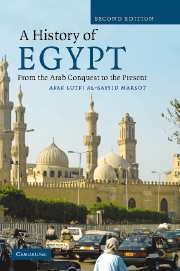Book contents
- Frontmatter
- Contents
- List of maps
- Preface
- Map 1 Egypt and its neighbours
- Map 2 Medieval Cairo
- 1 The Arab conquest of Egypt to the end of the Ayyubi dynasty, 639–1250
- 2 The age of the mamluks, 1250–1516
- 3 The Ottoman age, 1516–1805
- 4 The beginning of the state system, 1805–1922
- 5 The liberal experiment, 1922–52
- 6 The Nasser years, 1952–70
- 7 From Sadat to Mubarak, 1970 to the present day
- Select bibliography
- Index
3 - The Ottoman age, 1516–1805
Published online by Cambridge University Press: 05 June 2012
- Frontmatter
- Contents
- List of maps
- Preface
- Map 1 Egypt and its neighbours
- Map 2 Medieval Cairo
- 1 The Arab conquest of Egypt to the end of the Ayyubi dynasty, 639–1250
- 2 The age of the mamluks, 1250–1516
- 3 The Ottoman age, 1516–1805
- 4 The beginning of the state system, 1805–1922
- 5 The liberal experiment, 1922–52
- 6 The Nasser years, 1952–70
- 7 From Sadat to Mubarak, 1970 to the present day
- Select bibliography
- Index
Summary
Khair Bey ruled as the Ottoman viceroy (wali) until his death in 1522. The viceroy, or governor of the province, was frequently given the rank of pasha – although Khair Bey was not – from then on all governors are referred to as pashas, while the mamluks are collectively referred to as the beys or amirs. Within two years of Khair's death a revolt broke out and the new Ottoman sultan, Sulaiman the Lawgiver, as he was known to his own people, or the Magnificent, as he was known to the Western world, sent his grand vizier to suppress the revolt and to establish a form of administration that was spelled out in an edict, the qanunname. With minor modifications, that system of government remained in practice in Egypt until the eighteenth century.
According to the edict Egypt was divided into fourteen provinces covering the delta and Upper Egypt, each province administered by a government agent responsible to the wali. Upper Egypt, ranging from the town of Asiut to the southern borders, was administered by Arab tribal sheikhs acting as government agents. These tribal rulers continued to enjoy authority over the region until 1576, when a bey was finally appointed governor over the region. The concentration of bedouin tribes in Upper Egypt made tribal authority a viable (and cheaper) alternative to stationing government forces in the area.
The viceroy headed the administration of the entire province of Egypt and was appointed by the sultan from the imperial capital.
- Type
- Chapter
- Information
- A History of EgyptFrom the Arab Conquest to the Present, pp. 48 - 64Publisher: Cambridge University PressPrint publication year: 2007
- 1
- Cited by

